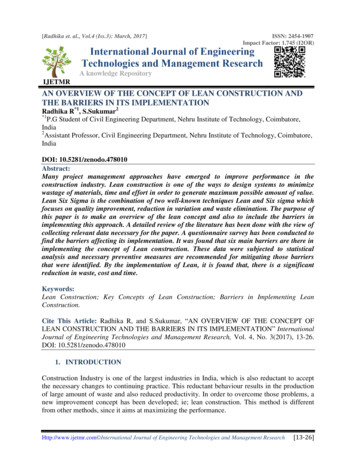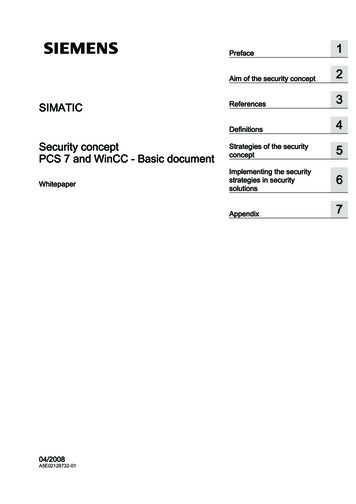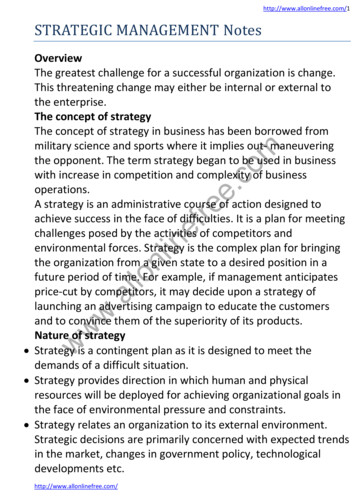
Transcription
[Radhika et. al., Vol.4 (Iss.3): March, 2017]ISSN: 2454-1907Impact Factor: 1.745 (I2OR)IJETMRAN OVERVIEW OF THE CONCEPT OF LEAN CONSTRUCTION ANDTHE BARRIERS IN ITS IMPLEMENTATIONRadhika R*1, S.Sukumar2*1P.G Student of Civil Engineering Department, Nehru Institute of Technology, Coimbatore,India2Assistant Professor, Civil Engineering Department, Nehru Institute of Technology, Coimbatore,IndiaDOI: 10.5281/zenodo.478010Abstract:Many project management approaches have emerged to improve performance in theconstruction industry. Lean construction is one of the ways to design systems to minimizewastage of materials, time and effort in order to generate maximum possible amount of value.Lean Six Sigma is the combination of two well-known techniques Lean and Six sigma whichfocuses on quality improvement, reduction in variation and waste elimination. The purpose ofthis paper is to make an overview of the lean concept and also to include the barriers inimplementing this approach. A detailed review of the literature has been done with the view ofcollecting relevant data necessary for the paper. A questionnaire survey has been conducted tofind the barriers affecting its implementation. It was found that six main barriers are there inimplementing the concept of Lean construction. These data were subjected to statisticalanalysis and necessary preventive measures are recommended for mitigating those barriersthat were identified. By the implementation of Lean, it is found that, there is a significantreduction in waste, cost and time.Keywords:Lean Construction; Key Concepts of Lean Construction; Barriers in Implementing LeanConstruction.Cite This Article: Radhika R, and S.Sukumar, “AN OVERVIEW OF THE CONCEPT OFLEAN CONSTRUCTION AND THE BARRIERS IN ITS IMPLEMENTATION” InternationalJournal of Engineering Technologies and Management Research, Vol. 4, No. 3(2017), 13-26.DOI: 10.5281/zenodo.4780101. INTRODUCTIONConstruction Industry is one of the largest industries in India, which is also reductant to acceptthe necessary changes to continuing practice. This reductant behaviour results in the productionof large amount of waste and also reduced productivity. In order to overcome those problems, anew improvement concept has been developed; ie; lean construction. This method is differentfrom other methods, since it aims at maximizing the performance.Http://www.ijetmr.com International Journal of Engineering Technologies and Management Research[13-26]
[Radhika et. al., Vol.4 (Iss.3): March, 2017]ISSN: 2454-1907Impact Factor: 1.745 (I2OR)There are many construction companies that are trying to enhance the performance by reducingall kind of problems in construction. These problems are the reason behind the project delays andtime and cost overruns.The scope of this paper is to review the concept of lean construction, its benefits and the barriersarised in its implementation. Data collection should be carried out from 30 constructioncompanies by direct observations, interviews, email questionnaire and through telephone. Basedon the gathered data, analysis was conducted to identify the factors affecting the industry. Afterthe identification of factors, there is a need to find the root causes of these factors or problems.By identifying the root causes and its extent, we can recommend the best measures to controlthese problems.2. LEAN CONSTRUCTIONLean Construction is an effective technique which aims at eliminating the wastes in construction.The goal of Lean construction is to achieve customer satisfaction by using less of everything ,ie;materials, money and resources. This construction method is most suitable for complex andspeed projects. It develops team work and also assigns the matching labor to the right work. Inthis concept, variation is under control by the practice of; Following a set of objectives Aiming at maximizing the extent of performance Concurrent designing of process Implementing production control throughout the entire life of project.It is a new form of the application of management concept into construction. These projects areeasier to manage safe, quick completion, reduced cost and also of appreciable quality (GregoryHowel,1999).3. KEY CONCEPTS OF LEAN CONSTRUCTIONThe key concept of lean construction is to enable the flow of steps by eliminating the non-valueadded activities which are time, resource or space consuming. It focuses on process improvementthrough the reduction of duration for each activity. The concept of Lean Construction providesthe base for the foundation of project management.The principles of Lean construction consists of seven keys that are specific value, Identify andmap the value stream, flows, pull, perfection, Transparency, process variability. Lean thinkingcan be redefined in the following three ways: They are unique custom product, Deliver instantly,Nothing in stores.( Harris and McCaffer,1997). The key concepts of Lean construction must beintroduced during the starting stage of construction.4. BARRIERS TO LEAN IMPLEMENTATION: A REVIEWAn overview of literatures collected from various journals is needed to identify and fix aproblem. The most noteworthy of them which are relevant to the current study are beingreviewed. A literature review is a search and evaluation of the available literature based on aHttp://www.ijetmr.com International Journal of Engineering Technologies and Management Research[13-26]
[Radhika et. al., Vol.4 (Iss.3): March, 2017]ISSN: 2454-1907Impact Factor: 1.745 (I2OR)subject or chosen field of study. It documents the contents with respect to the subject or topicthat we are writing about. According to Gaoshang(2014), lean practices and associated barriers in implementinglean factors in China construction industry were identified. The factors identified in thispaper include lack of long term philosophy, absence of lean culture, use of multi-layersubcontracting, people and partner issues, and also issues related to managerial andorganizational, lack of support, culture and philosophy, Government and procurement.Forbes et al(2002), in his paper explains that the main obstacle to implementation of leanis that the construction firms do not focus on productivity and quality.Alinaite(2009) highlighted barriers as technical aspects. According to him, the barrierscan be divided into two groups; viz barriers those influence the worker productivity andthose barriers which are easier to overcome.Olatunji(2008), classified the barriers of implementing lean into seven groups which areskills and knowledge related, management related, Government related, Attitude related,resource related and logistics related.Abdulla et al and Mossman (2009), suggests that lack of top management commitmentwas one of the main barriers in Lean construction implementation. He also added that,lack of communication among the labors and top management may also cause barriers inLean Construction adoption.In Howell’s (1999) opinion, human attitude slows down the execution of Leanconstruction in the industry, lack of discussions and meetings also leads to the decrease inLean construction adoption.Olatunji(2008),describes the barriers on the basis of financial aspects. Poor managementof time, Lack of incentives, low wages etc are some of the examples of the barriers inLean Construction implementation.Skill echnicalaspectsFigure 1: Different aspects of Lean barriersHttp://www.ijetmr.com International Journal of Engineering Technologies and Management Research[13-26]
[Radhika et. al., Vol.4 (Iss.3): March, 2017]ISSN: 2454-1907Impact Factor: 1.745 (I2OR)5. METHODOLOGYIn this paper, a list of barriers as explained above and a questionnaire has been prepared. Thedata were gathered through questionnaire survey from 30 construction companies. Thequestionnaire survey was conducted on the basis of 4-point Likert scale, scaling from Stronglyagree (1) to Strongly disagree (4). The results obtained from the data are evaluated in order toidentify the 6 critical factors in implementing lean in construction industry. The data wereanalyzed using SPSS Software and ranked on the basis of their Relative Important Index. Fromthe analysis, the cause and effects of these barriers are obtained. A cause and effect diagram mustbe generated representing the cause and effect of factors affecting the implementation of Leanconstruction. By using proper remedial measures, the identified problems can be mitigated. Theadopted actions will be implemented in the current and future works in order to overcome thebarriers in Lean Construction Implementation. The following flow chart represents theMethodology of this paper that is explained above.LITERATURE REVIEWPROBLEM IDENTIFICATIONPREPARING QUESTIONNAIREDATA COLLECTIONANALYSIS USING SPSS SOFTWARERESULT AND DISCUSSIONEVALUATION AND CONCLUSIONFigure 2: Methodology6. BARRIERS IN LEAN IMPLEMENTATIONBased on the relative important Index method analysis, the ranking is provided according to thedata. From this analysis, the six most critical factors are identified and are given in the followingtable. These barriers have been chosen on the basis of their Relative Important index, where theRelative Important Index are calculated using the formula:Http://www.ijetmr.com International Journal of Engineering Technologies and Management Research[13-26]
[Radhika et. al., Vol.4 (Iss.3): March, 2017]ISSN: 2454-1907Impact Factor: 1.745 (I2OR)RII(%) Σa*(n/N)*(100/5)Where, RII Relative Important Index a constant expression weight n frequency of response N total number of responseTable 1: The Six Topmost Barriers in Lean ImplementationBarriersEquipment breakdownWork structuringLack of skilled laboursWorks defectsPoor materialmanagementExternal delayRank1234567. CAUSES OF BARRIERS FOR LEAN IMPLEMENTATIONThis section is designed to assess the barriers for lean implementation from the literature reviewand also from the questionnaire survey. There are in total of about six critical factors that acts asbarriers. They are equipment break down, Work structuring, Lack of skilled labors, Workdefects, Poor material management and external delays. These barriers and their causes are givenin the figure 3.The extent of each causes can be depicted by using a Pareto chart. A pareto chart is a bar graphand are arranged with longest bars on the left and the shortest bar on right. The longestbars depicts the most critical causes of a problem and the shortest bars depicts the causeshaving less impact. In this way, the chart visually depicts which situations are moresignificant. The paretochart explaining the extent of each factors in the constructionindustry is given in the following section.Http://www.ijetmr.com International Journal of Engineering Technologies and Management Research[13-26]
[Radhika et. al., Vol.4 (Iss.3): March, 2017]ISSN: 2454-1907Impact Factor: 1.745 (I2OR) Not reading operator's manual Improper maintenance Poor electrical connectionEquipment Break Not replacing worn parts when needed Ignoring warning signalsdownWork Structuring Lack of constructability Waiting for information Increase in scope of work Slow to make decisions Mistake in work contract Great number of change ordersLack of Skilledlabors Ineffective training Mental condition of employee Using improper tools Non usage of PPE Misuse of construction equipment Inadequate supervisionWork defects Design deficiencies Material deficiencies Specification problems Lack of standards Poor qualityPoor materialmanagement Quality of material Shortage of material Supply of material Late delivery Rise in material prices Inadequate materialExternal delays Weather conditions Natural disasters Regulatory changes Organizational changes Slow site clearance Geological and geographical conditionFigure 3: Causes of Barriers in Construction IndustryHttp://www.ijetmr.com International Journal of Engineering Technologies and Management Research[13-26]
[Radhika et. al., Vol.4 (Iss.3): March, 2017]ISSN: 2454-1907Impact Factor: 1.745 (I2OR)8. EQUIPMENT BREAK DOWNBreak down of equipment can be defined as its failure to function. It has the following effects onconstruction industry; Time Overrun, Additional Labour Cost, Extra Demand Of Equipment,Lack Of Continuity, Need Of Rental Equipment, Waste Of Equipment Usage. The extent of eachcauses in construction industry and also the preventive measures are given below.CAUSES OF EQUIPMENT BREAK DOWNCOUNTCUMULATIVE PERCENTAGE10092.1529175172.583.9034205266.25 63.75 63.75 63.75 61.2575.2515090553.75 51.25 3.9436619712.2736418576.25Figure 3: Pareto chart for Equipment breakdown8.1.CONTROL MEASURES FOR EQUIPMENT BREAK DOWNTaking steps to reduce the equipment break down can seem overwhelming, but the money saved,and additional profits earned from making adjustments to reduce downtime are worthwhile. Toeliminate equipment break down, the following measures can be adopted.1) Implement an automatic tracker that will detect downtime immediately and be able toalert you in real time to problems that have occurred. Then, find out why each instanceoccurred.2) User errors can be controlled properly by training their employees to know how to usetools effectively.3) Involving your staff members in the decision process helps them feel more invested inyour works and gives them an incentive to work toward achieving the profits.4) To prevent the problem of maintenance, practicing regular, ongoing preventativemaintenance strategies, is important for keeping machines from breaking down.5) Set specific company goals for reducing errors and improving productivity. Then, offerbonus amount to employees who reach those goals.Http://www.ijetmr.com International Journal of Engineering Technologies and Management Research[13-26]
[Radhika et. al., Vol.4 (Iss.3): March, 2017]ISSN: 2454-1907Impact Factor: 1.745 (I2OR)6) Effective lubrication is extremely critical to all equipments and will help prevent gear andbearing failures.7) A higher grade belt like EPDM belt, which can resist higher temperature and longer life,can be used for the purpose of belt deterioration and improper alignment.9. LACK OF SKILLED LABORSUnskilled labor is a segment of the workforce associated with a limited skill set or minimaleconomic value for the work performed. Skill shortages can have many causes such as generalunder-investment in skills development; rapid structural change combined with low levels ofoverall unemployment; and particular spots of weakness in the training system. The extent ofeach causes and the control measures are as below.CAUSES OF SKILLED LABOURSCOUNT77.5CUMULATIVE 5 52.5 66.8151447751.25 48.7543.75 8084632563.75 63.75Figure 4: Paretochart for Skilled Labors9.1.CONTROL MEASURES FOR LABOR PROBLEMSThe Shortage and lack of experience of skilled worker may result in lack of trade’s skills whichlead to waste. lack of experience of skilled labor was the main cause of building waste on sites.1) Conduct awareness about accident prevention programmes and the loss that occurs due toaccidents.2) Share jobs between employees by replacing full time employees with part time workers.3) Providing cross training to employees enable us to make changes including layoff andalso helps to perform a variety of operations.4) The problem due to technology change can be reduced by improved worker educationand training.5) Increase the level of compensationHttp://www.ijetmr.com International Journal of Engineering Technologies and Management Research[13-26]
[Radhika et. al., Vol.4 (Iss.3): March, 2017]ISSN: 2454-1907Impact Factor: 1.745 (I2OR)6) Provide PPE and force them to use protective equipment’s and also make them awareabout the necessity of those equipment’s.10. WORK STRUCTURINGWork structuring determines how the work of a system is structured in terms of how resourcesare organized down to the design of operations. If the work structuring is not properly managedduring construction it leads to poor quality, rework and large variations in work flow. The effectsof work structuring in construction are Arbitration, Work Postponement, Variation In ScheduledWork, Extension Of Time, Slow Down Of Work, LitigationCAUSES OF WORK STRUCTURINGPROBLEMSCOUNT82.5CUMULATIVE 45553.75 52.5 66.0907127452.5 48.75 47.5 .2548596172.5Figure 5: Paretochart for Work Structuring Problems10.1.CONTROL MEASURES FOR PROBLEMS IN WORK STRUCTURINGThe work structuring is complete when the activities described on it are detailed enough to letyou schedule, budget and delegate the work. In order to control the problems in work structuring,following points can be considered:1) Schedule the daily task for the next week.2) Order material deliveries and line up labours3) Limit socializing and schedule daily breaks4) Monitor the weather and document5) Update the critical path6) Develop Responsibility Assignment Matrix7) Assign the schedule for Rework, retesting and refurbishingHttp://www.ijetmr.com International Journal of Engineering Technologies and Management Research[13-26]
[Radhika et. al., Vol.4 (Iss.3): March, 2017]ISSN: 2454-1907Impact Factor: 1.745 (I2OR)11. WORK DEFECTSDefects are caused by incorrect method due to non-standard operations, differences in theway that processes are undertaken by different operators. They fail to maintainequipment, machines and fixtures and these may allow defects to occur. Lack ofmotivation, Lack of knowledge, Lack of communication, Defective building materials,Insufficient supervision, Faulty design are the effects of work defects in the industry.CAUSES OF WORK DEFECTSCOUNTCUMULATIVE 5 61.25 6057.5 66.521739135552.556.5217391342.5 .25Figure 6: Paretochart for Work Defects11.1.CONTROL MEASURES FOR WORK DEFECTSDefects are caused by incorrect method due to the failure in standard operations, differences inthe way that processes are being undertaken before. They fail to maintain equipment, machinesand fixtures and these may allow defects to occur. In order to control work defects, followingmeasures can be adopted:1) Implement a comprehensive quality control program to avoid construction defect claims,improvement in safety, and limit costs with delayed delivery dates and rework.2) Conduct pre-construction meetings to review plans and specifications and discusspotential issues.3) Maintain project-related records, such as inspections, materials, schedules.4) Ensure Proper Production Management during the Design phase: During design phase,architect should implement procedures that will subject the design to extensive reviewand analysis before it is released to construction.5) Maintain open communication between Designer, architect and contractor throughout theproject.Http://www.ijetmr.com International Journal of Engineering Technologies and Management Research[13-26]
[Radhika et. al., Vol.4 (Iss.3): March, 2017]ISSN: 2454-1907Impact Factor: 1.745 (I2OR)6) Limit overtime and shift work where possible12. POOR MATERIAL MANAGEMENTMaterial management is the process which ensures that the right materials are available at theright place at the right time in the right quantity and quality and at the right cost. Procurement,Stocking of materials, Availability of spares etc belongs to material management. Poor materialmanagement produces construction wastes and cost overrun. The effects of poor materialmanagement are Poor Quality Of Work, Wastage Of Materials, Loss Of Wealth, Raise The RiskOf Damage, Loss Of Time, Loss Of Capacity.CAUSES OF POOR MATERIALMANAGEMENTCOUNTCUMULATIVE veryinadequate rise in shortage of inadequate supply ofquality of materialmaterial materialmaterialmaterialpricesFigure 7: Paretochart for Poor Material Management12.1.CONTROL MEASURES FOR POOR MATERIAL MANAGEMENTImproved material management saves time, manages inventory, generates invoices, andimproves cash flow. Following are the points which help to control Poor Material management:1) Proper Planning and Scheduling2) Monitoring and Controlling of all construction activities in material management areconducted to ensure the right source of materials with quality are available at the righttime and for minimum cost construction process3) In order to use the resources in an optimal way and to minimize costs,The organizationmust be structured to provide for the timely performance of the work.4) Enough provision should be provided for Material storage, protection and control ofbuilding materials and components on site during the construction process5) Better planning of raw materials on site can help to eliminate project delays and reducesactivity times, resulting in better service.Http://www.ijetmr.com International Journal of Engineering Technologies and Management Research[13-26]
[Radhika et. al., Vol.4 (Iss.3): March, 2017]ISSN: 2454-1907Impact Factor: 1.745 (I2OR)13. EXTERNAL DELAYSConstruction delays can be considered as time lag in completion of activities from a fixed time asper contract. When project delay occurs it means project cannot be completed within stated time.The effects are poor quality of work, wastage of materials, loss of wealth, raise the risk ofdamage, loss of time, loss of capacity.CAUSES OF EXTERNAL DELAYSCOUNTCUMULATIVE PERCENTAGE10078.7588.83374696575.9305210956.2552.5 52.5 58.75 56.2546.2560.2977667537.5 83623Figure 8: Paretochart for External Delays13.1.CONTROL MEASURES FOR EXTERNAL DELAYSConstruction delays can be considered as time lag in completion of activities from a fixed time asper contract.These delays can be controlled by;1) Thorough and accurate planning.2) Using a knowledgeable designer can help mitigate communication problems.3) Using materials and a system that can resist moisture and stain can prevent triggering themechanism4) Inspections have to be timed correctly to keep a project flowing smoothly,5) Each party should know what is going on with each phase To prevent frequent changes ofdesign and construction.6) Documentation of details containing plans, changes, inspections, orders and progress iskey to avoiding delays.14. CONCLUSIONLean is a best and effective concept which is about designing and operating the right process atthe right time. The basic idea of lean six sigma is that if performance is improved, there will bean increase in the quality, energy sources and environment and reduction in waste. The mainHttp://www.ijetmr.com International Journal of Engineering Technologies and Management Research[13-26]
[Radhika et. al., Vol.4 (Iss.3): March, 2017]ISSN: 2454-1907Impact Factor: 1.745 (I2OR)objective of this paper was to find the major barriers in lean implementation such as equipmentbreak down, work structuring, external delays, poor material management, This paper presentsan exploratory study on the results of questionnaire survey among construction participants toexplore the factors. The most affected factors are identified by ranking using Statistical Packagefor Social Sciences analysis.In this paper, the barriers in implementing lean, the causes and their extent on construction areexplained. Also includes the control measures for each barriers that can be recommended for thefuture use. By adopting these measures, the benefits like Reduced overhead cost, Elimination ofhazard, Increased profitability, Reduced variability, Reduced lead time, Better quality ofmaterials, Reduced rework, Improved work efficiencies, Minimize the chances of future delay,Elimination unnecessary cost can be achieved.15. ACKNOWLEDGEMENTOn the very beginning of this paper, I would like to prolong my sincere & heartfelt responsibilitytowards all the personalities who have helped me in the completion of this undertaking, Withouttheir active guidance, help, cooperation & encouragement, I would not have completed thispaper.16. REFERENCES[1] Ahmed Mousa., Lean, six sigma and lean six sigma Overview, International Journal ofScientific & Engineering Research, Volume 4, (Issue 5), May.2013, pp. 1137-1153[2] S. Sriram., Implementation of Six Sigma Concepts in Construction Project for EnsuringQuality Improvements, International Journal of Innovative Research in Science,Engineering and Technology, Volume. 5. (Issue 4), 2016, pp. 4913-4921.[3] S M Abdul Mannan Hussain1 , Barriers To Implement Lean Principles In The IndianConstruction Industry, International Journal Of Innovative Research In AdvancedEngineering (IJIRAE) ISSN: 2349-2763 , Issue 01, Volume 3 (January 2016).[4] Mohd Arif Marhani , Aini Jaapara, Nor Azmi Ahmad Baria, Mardhiah Zawawib.Sustainability through Lean Construction Approach: A literature review Procedia –Social and Behavioral Sciences 101(2013),90-99.[5] Abdelhamid, T.S. (2003). Six-Sigma in Lean Construction Systems Opportunities andChallenges. Retrieved 26 August 2012 from http://www.leanconstruction.dk[6] Abdullah, S., Abdul Razak, A., Abu Bakar, A. H. & Mohammad, I. S. (2009). TowardsProducing Best Practice in the Malaysian Construction Industry: The Barriers inImplementing the Lean Construction Approach. Retrieved 26 August 2011 fromhttp://eprints.usm.my[7] Alinaitwe, H.M. (2009). Prioritising Lean Construction Barriers in Uganda'sConstruction Industry. Journal of Construction in Developing Countries, 15-30.[8] Howell, G.A. (1999). What is Lean Construction?. Proceeding Seventh AnnualConference Of International Group Of Lean Construction, IGLC-7, University OfCalifornia, Berkeley, CA, USA.[9] Pepper, M.P.J and Spedding, T.A. (2010). The evolution of Lean Six Sigma .International Journal of Quality & Reliability Management, 27 (2), 138-155.Http://www.ijetmr.com International Journal of Engineering Technologies and Management Research[13-26]
[Radhika et. al., Vol.4 (Iss.3): March, 2017]ISSN: 2454-1907Impact Factor: 1.745 (I2OR)[10] Koskela, L. (1992) Application of the new production philosophy to construction. Tech.Report No. 72. CIFE, Stanford University, CA.[11] Olatunji ,J. (2008).Lean in Nigerian Construction state, barriers, strategies and “go -togemba” approach. Proceedings: IGLC-16, 14-20 July, Manchester, UK.Http://www.ijetmr.com International Journal of Engineering Technologies and Management Research[13-26]
The extent of each causes can be depicted by using a Pareto chart. A pareto chart is a bar graph and are arranged with longest bars on the left and the shortest bar on right. The longest bars depicts the most critical causes of a problem and the shortest bars depicts the causes having less impact. In this way, the chart visually depicts which .











